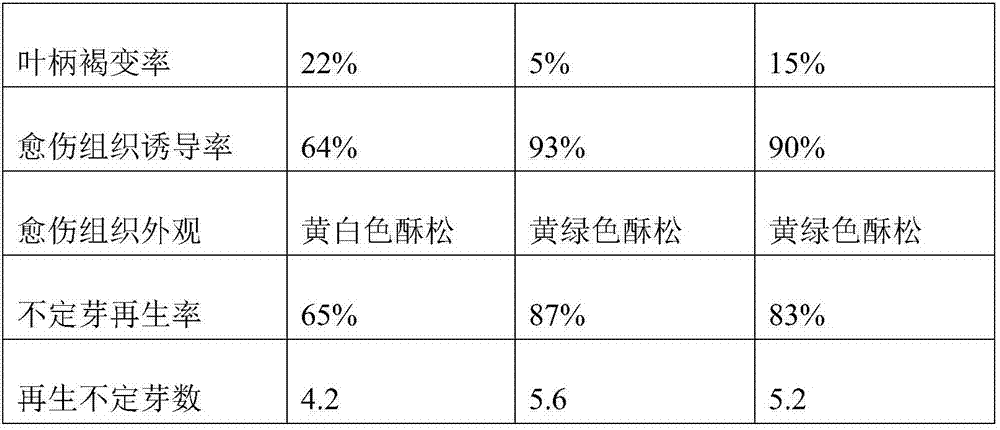Kiwi fruit tissue culture method and application thereof
A tissue culture and kiwifruit technology, applied in the field of plant tissue culture, can solve the problems of tissue culture regeneration without Qionglu kiwifruit, and achieve the effects of improving induction rate, high survival rate and reducing pollution rate.
- Summary
- Abstract
- Description
- Claims
- Application Information
AI Technical Summary
Problems solved by technology
Method used
Image
Examples
Embodiment 1
[0066] The selection of embodiment 1 explant
[0067] The invention adopts the newly germinated petioles, leaves and stems of Actinidia kiwifruit in spring as explant materials for disinfection and callus induction.
[0068] 1. Selection and sterilization of explants
[0069] Collect new shoots of "Qionglu" in the same year, use a small soft brush to scrub in detergent solution for 5-10 minutes, rinse with water for 3-4 hours, cut off the leaves and petioles, and cut the branches into 2-3cm stems segments (excluding axillary buds). Use 75% alcohol to sterilize leaves, petioles, and stems for 30 seconds in an ultra-clean workbench, rinse with sterile water once, then sterilize with 0.1% mercuric chloride for 40 seconds to 1 minute, and rinse with sterile water for 4 to 5 times. Dry the water with sterile filter paper, cut the leaves into 0.2 cm wide slender strips along the transverse veins, cut the petioles into 0.5 cm long, and cut the stems into 0.5-1 cm long for inoculati...
Embodiment 2
[0081] Comparison of different sterilization methods of embodiment 2
[0082] In order to overcome the incomplete sterilization of kiwifruit petiole by conventional disinfection methods, this application uses different methods to treat the petiole of Qionglu kiwifruit, and evaluates the pollution rate of petiole in the tissue culture process and the callus and variable number of petioles under different treatment methods. bud-inducing effect.
[0083] Treatment method 1: collect the young branches of "Qionglu" in the same year, use a small soft brush to scrub in the aqueous solution of detergent for 5-10 minutes, rinse with clean water for 3-4 hours, cut off the petiole, and use 75% water on the ultra-clean workbench Sterilize the petiole with alcohol for 30 seconds, rinse it once with sterile water, then sterilize it with 0.1% mercuric chloride for 2-3 minutes, and rinse it with sterile water 4-5 times. Dry the water with sterile filter paper, cut the petiole into 0.5 cm lon...
Embodiment 3
[0091] The optimization of embodiment 3 axillary bud germination medium
[0092] In order to improve the germination rate of axillary buds, the present application contains 30g·l -1 Sucrose and 7g·l -1 The MS medium of agar is used as the basic medium, and the types and contents of plant hormones are optimized in order to obtain the axillary bud germination medium with the best induction effect. The specific optimization method is as follows:
[0093] (1) Add the hormone combination prepared according to Table 3 into the basal medium to prepare different axillary bud germination medium; (2) Sterilize the axillary bud stem section of "Qionglu" kiwifruit and transfer them to each medium for Aseptic culture, disinfection mode and culture condition refer to embodiment 2 treatment mode 2; (3) record the germination situation of axillary bud.
[0094] Hormone combination formula of table 3 axillary bud germination medium
[0095]
[0096]
[0097] Table 4 Germination of ax...
PUM
 Login to View More
Login to View More Abstract
Description
Claims
Application Information
 Login to View More
Login to View More - R&D
- Intellectual Property
- Life Sciences
- Materials
- Tech Scout
- Unparalleled Data Quality
- Higher Quality Content
- 60% Fewer Hallucinations
Browse by: Latest US Patents, China's latest patents, Technical Efficacy Thesaurus, Application Domain, Technology Topic, Popular Technical Reports.
© 2025 PatSnap. All rights reserved.Legal|Privacy policy|Modern Slavery Act Transparency Statement|Sitemap|About US| Contact US: help@patsnap.com



